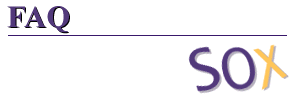
|
1. What is SOX? |
|
1. What is SOX?
Schema for Object-oriented XML, or SOX, is a data description language built with XML. It uses the standard XML data model to produce XML documents but is defined by stronger constraints and a more powerful validation of document structure. This enables XML-based distributed applications for integrating business systems.
2. Why was SOX developed?
Commerce One developed SOX to improve upon the data abstraction provided by XML. SOX assists in the integration of heterogeneous application systems by maximizing XML's ability to talk to databases over networks and representing the full range of abstraction required for data document exchange. For example, it is impossible in XML to declare that a given string is a numeric value and must conform to the standard representation of American dollars, Russian rubles, Japanese yen, or another currency. In SOX, however, this can be easily displayed. This allows a database to expect a string of a given length and type, ensuring that the data is more accurately represented in the documents produced from SOX.
3. What does SOX add to XML?
SOX extends XML to provide:
4. What are the benefits of SOX?
SOX benefits both the application developer and the document designer. For the application developer, SOX enables developers to use XML/SOX processors to transform SOX documents to programming language code, XML DTDs, and documentation. SOX also adds data type, enumeration, and bounds condition support for document validation. For the document designer, SOX adds object-oriented programming principles to XML, defines document modularization and reuse through inheritance, makes document definitions more readable, allows any XML editor to define SOX documents, and easily incorporates definitions from other schemas.
5. How does SOX relate to other XML specifications?
SOX is an XML schema language influenced by predecessors such as XML Data, DCD, and other schema. As a superset of XML, SOX can model anything that XML can-and more. SOX output is an XML document and is represented by an XML DTD. As a result, SOX-based documents can be generated by any XML authoring tool, though XML tools are not able to validate a SOX instance without a SOX-compliant parser. The W3C is currently in the process of defining a recommended schema language. Commerce One has representatives on the XML Schema Working Group and its software will fully support the XML schema language submitted by that body.
6. Why is Commerce One making SOX available?
By participating in the W3C standards process, Commerce One has positioned itself on the cutting edge of XML schema technology. By making the SOX specification available, Commerce One offers the community at large the opportunity to participate in a work-in-progress. Your comments on the SOX submissions are welcome at the xCBL discussion group.
7. What is the latest version of SOX?
Version 2.0 is the current release of SOX. SOX version 2.0 can be reviewed at Commerce One.net and is currently in the process of being prepared for review by industry consortium. Commerce One xCBL 2.0 is implemented using SOX version 2.0.
8. Where can I find more information regarding SOX?
The SOX version 2.0 specifications are available at the SOX download page and the current SOX W3C submission is available at http://www.w3.org/TR/NOTE-SOX/. Both sites will report on the ongoing XML schema efforts, and Commerce One will provide examples by updating the schematized version of xCBL.